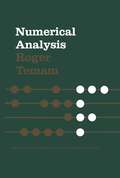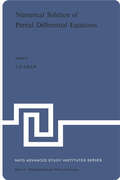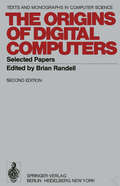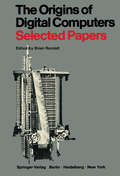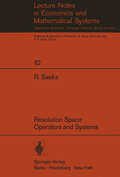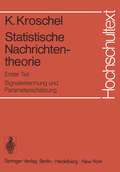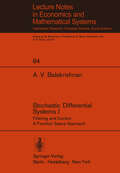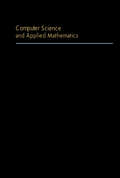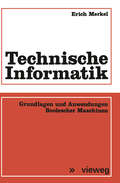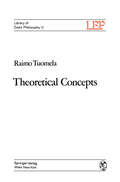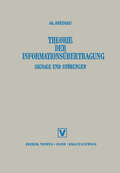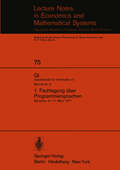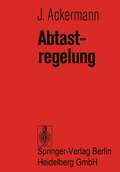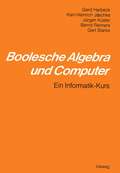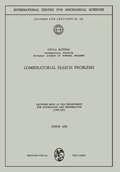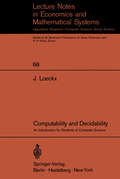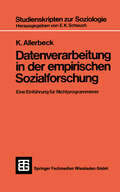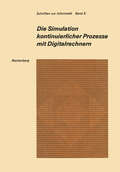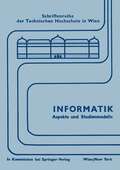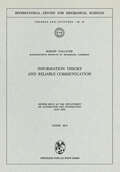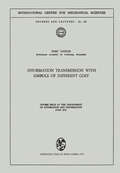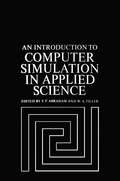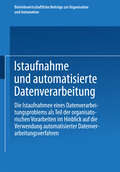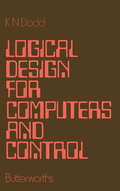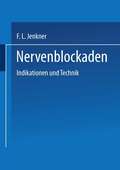- Table View
- List View
Numerical Analysis
by R. TemanThis book is an introduction to one of the important as pects of Numerical Analysis, namely the approximate solution of functional equations. We intend to show, by a few brief examples, the different theoretical and practical problems related to the numerical approximation of boundary value problems. We have chosen for this the approximate solution of certain linear elliptic partial differential equations (the first two parts of the book) and the approximate solution of a nonlinear elliptic differential equation. This book is not a systematic study of the subject, but the methods developed here can be applied to large classes of linear and nonlinear elliptic problems. The book assumes that the reader's knowledge of Anal ysis is comparable to what is taught in the first years of graduate studies. This means a good knowledge of Hilbert spaces, elements of measure theory and theory of distributions. The subject matter of the book covers the usual content of a first course on Numerical Analysis of partial differential equations.
Numerical Solution of Partial Differential Equations: Proceedings of the NATO Advanced Study Institute held at Kjeller, Norway, August 20–24, 1973 (Nato Science Series C: #2)
by J. G. GramThis book contains the transcripts of the invited lectures presented at the NATO Advanced Study Institute on "Numerical Solution of Partial Differential Equations". The Study Institute was held at the Netherlands-Norwegian Reactor School, Institutt for Atomenergi, Kjeller, Norway, 20th - 24th August 1973. The members of the Scientific Advisory Committee were: A. R. Mitchell, University of Dundee, Scotland I. HoI and, University of Trondheim, Norway T. Havie, UniverSity of Trondheim, Norway The members of the Organizing Committee were: E. Andersen, Institutt for Atomenergi, Kjeller, Norway G. E. Fladmark, Institutt for Atomenergi, Kjeller, Norway J. G. Gram, Institutt for Atomenergi, Kjeller, Norway The aim of the Study Institute was to bring together mathe maticians and engineers working with numerical methods. The papers presented covered both theory and application of methods for solution of partial differential equations. The topics were finite element methods, finite difference methods, and methods for solution of linear and nonlinear systems of equations with application to continuum mechanics and heat transfer. The total number of participants was 68. Their names are given at the end of the book. The publication of these proceed ings could be realized through the kind cooperation of the lec turers. The Advanced Study Institute was financially sponsored by NATO Scientific Affairs Division. The Organizing Committee wishes to express its gratitude for this support. Valuable assistance was given by Mrs. G.
The Origins of Digital Computers: Selected Papers (Monographs in Computer Science)
by B. RandellMy interest in the history of digital computers became an active one when I had the fortune to come across the almost entirely forgotten work of PERCY LUDGATE, who designed a mechanical program-controlled computer in Ireland in the early 1 'JOO's. I undertook an investigation of his life and work, during which I began to realise that a large number of early developments, which we can now see as culminating in the modern digital computer, had been most undeservedly forgotten. Hopefully, historians of science, some of whom are now taking up the subject of the development of the computer and accumulating valuable data, particularly about the more recent events from the people concerned, will before too long provide us with comprehensive analytical accounts of the invention of the computer. The present book merely aims to bring together some of the more important and interesting written source material for such a history of computers. (Where necessary, papers have been translated into English, but every attempt has been made to retain the flavour of the original, and to avoid possibly misleading use of modern computing terminology.
The Origins of Digital Computers: Selected Papers
by B. RandellMy interest in the history of digital computers became an active one when I had the fortune to come across the almost entirely forgotten work of PERCY LUDGATE, who designed a mechanical program-controlled computer in Ireland in the early I ':ICC's. I undertook an investigation of his life and work, during which I began to realise that a large number of early developments, which we can now see as culminating in the modern digital computer, had been most undeservedly forgotten. Hopefully, historians of science, some of whom are now taking up the subject of the development of the computer and accumulating valuable data, particularly about the more recent events from the people concerned, will before too long provide us with comprehensive analytical accounts of the invention of the computer. The present book merely aims to bring together some of the more important and interesting written source material for such a history of computers. (Where necessary, papers have been translated into English, but every attempt has been made to retain the flavour of the original, and to avoid possibly misleading use of modern computing terminology.
Resolution Space, Operators and Systems (Lecture Notes in Economics and Mathematical Systems #82)
by R. SaeksIf one takes the intuitive point of view that a system is a black box whose inputs and outputs are time functions or time series it is natural to adopt an operator theoretic approach to the stUdy of such systems. Here the black box is modeled by an operator which maps an input time function into an output time function. Such an approach yields a unification of the continuous (time function) and discrete (time series) theories and simultaneously allows one to formulate a single theory which is valid for time-variable distributed and nonlinear systems. Surprisingly, however, the great potential for such an approach has only recently been realized. Early attempts to apply classical operator theory typically having failed when optimal controllers proved to be non-causal, feedback systems unstable or coupling networks non-lossless. Moreover, attempts to circumvent these difficulties by adding causality or stability constraints to the problems failed when it was realized that these time based concepts were undefined and; in fact, undefinable; in the Hilbert and Banach spaces of classical operator theory.
Statistische Nachrichtentheorie: Erster Teil: Signalerkennung und Parameterschätzung (Hochschultext)
by Kristian KroschelStochastic Differential Systems I: Filtering and Control A Function Space Approach (Lecture Notes in Economics and Mathematical Systems #84)
by A. V. BalakrishnanThis book is an outgrowth of a graduate course by the same title given at UCLA (System Science Department). presenting a Functional Analysis approach to Stochastic Filtering and Control Problems. As the writing progressed. several new points of view were developed and as a result the present work is more in the nature of a monograph on the subject than a distilled compendium of extant works. The subject of this volume is at the heart of the most used part of modern Control Theory - indeed. the bread-and-butter part. It includes the Linear (Bucy-Kalman) Filter Theory. the Feedback Control (regulation and trz.cking) Theory for plants with random disturbances. and Stochastic DifEerential Games. Linear Filter Theory is developed by a 3-Martingale approach and is perhaps the sleekest one to date. We hasten to add that although the terITlS are Engineering-oriented. and a background in Control Engineering is essential to understand the motiva tion. the work is totally mathematical. and in fact our aim is a rigorous mathematical presentation that is at once systematic. We begin with some preliminary necessary notions relating to Stochastic Processes. We follow Parthasarathy's work in inducing Wiener measure on the Banach Space of Continuous functions. We introduce the linear Stochastic integrals right away. We are then ready to treat linear Stochastic Differential Equations. We then look at the measures induced.
Symbolic Logic and Mechanical Theorem Proving
by Chin-Liang Chang Richard Char-Tung LeeThis book contains an introduction to symbolic logic and a thorough discussion of mechanical theorem proving and its applications. The book consists of three major parts. Chapters 2 and 3 constitute an introduction to symbolic logic. Chapters 4-9 introduce several techniques in mechanical theorem proving, and Chapters 10 an 11 show how theorem proving can be applied to various areas such as question answering, problem solving, program analysis, and program synthesis.
Technische Informatik: Grundlagen und Anwendungen Boolescher Maschinen
by Erich MerkelDie "Technische Informatik" - ein Teilgebiet der Informatik - beschreibt die Funktions weise von programmgesteuerten digitalen Rechnern (kurz: Computern) und von anderen datenverarbeitenden Maschinen. Dieses Buch soll - in Form eines Praktikums - in wichtige Fragestellungen und Probleme der technischen Informatik einfUhren. Wer einen Computer zur Lösung eines Problems verwendet, braucht dafür im Grunde nur eine Bedienungsanleitung. Es ist aber keine Frage, daß ein Wissen über die Funk tionsweise des Rechners zusätzliche Anwendungsmöglichkeiten und eine bessere Aus nutzung seiner Fähigkeiten erschließt. Zum wirksameren Einsatz des Computers braucht man allerdings nicht die Einzelheiten der "hardware", d.h. den technischen Aufbau mit Dioden, Transistoren, integrierten Schaltkreisen usw., zu kennen. Es genügt eine Ein sicht in die logische Struktur des Computers. Die logische Struktur ergibt sich aus dem Aufbau des Rechners aus elementaren "Logikmaschinen" fur die Verknüpfungen Kon junktion (UND), Disjunktion (ODER) und Negation (NICHT) sowie aus den Speicher elementen. Diese Bauteile sind zu einem Netzwerk hoher Komplexität zusammenge schaltet. Von den Logikmaschinen, die auch "Gatter" genannt werden, braucht man nur zu wissen, daß sie einer Kombination von Eingangssignalen ein bestimmtes Ausgangssignal gemäß den Wertetafeln für die logischen Verknüpfungen zuordnen. Verwendet ein Lehrer die Logikmaschinen in dieser Weise als "black boxes" , so kann er bereits in der Sekundarstufe 1 einfache logische Strukturen des Computers, wie etwa den Addierer, erläutern. Allerdings werden dabei einige theoretische Grundlagen, z.B. aus der Aus sagenalgebra oder vom Rechnen im Dualsystem, vorausgehen müssen.
Theoretical Concepts (LEP Library of Exact Philosophy #10)
by R. Tuomelato that goal, and it is hoped that it will incorporate further works dealing in an exact way with interesting philosophical issues. Zurich, April 1973 Mario Bunge Preface In this book I have investigated the logical and methodological role of the much debated theoretical concepts in scientific theories. The philosophical viewpoint underlying my argumentation is critical scientific realism. My method of exposition has been to express ideas first in general terms and then to develop and elaborate them within a specific formal framework. It is assumed in the book that the reader has a relatively good knowledge of the basic techniques and results of modern symbolic logic, including model theory. Examples from actual science are mostly from the social sciences. I have deliberately omitted a treatment of a number of characteristic features which are particular to theoretical concepts in the more developed sciences, such as modern physics. This book owes very much to Professor Jaakko Hintikka, to whom I wish to express my deep gratitude. Especially at the begin ning of this project in 1968/69 when I was doing research for my doctoral degree at Stanford University I worked with him closely.
1. Fachtagung über Programmiersprachen: München, 9.–11. März 1971 (Lecture Notes in Economics and Mathematical Systems #75)
by Hans Langmaack Manfred PaulCombinatorial Search Problems: Lectures held at the Department for Automation and Information June 1972 (CISM International Centre for Mechanical Sciences #145)
by Gyula KatonaComputability and Decidability: An Introduction for Students of Computer Science (Lecture Notes in Economics and Mathematical Systems #68)
by J. LoeckxThe present Lecture Notes evolved from a course given at the Technische Hogeschool Eindhoven and later at the Technische Hogeschool Twente. They are intended for computer science students; more specifically, their goal is to introduce the notions of computability and decidability, and to prepare for the study of automata theory, formal language theory and the theory of computing. Except for a general mathematical background no preliminary knowledge is presupposed, but some experience in programming may be helpful. While classical treatises on computability and decidability are oriented towards the foundation of mathematics or mathematical logic, the present notes try to relate the subject to computer science. Therefore, the expose is based on the use of strings rather than on that of natural numbers; the notations are similar to those in use in automata theory; in addition, according to a common usage in formal language theory, most of the proofs of computability are reduced to the semi-formal description of a procedure the constructivity of which is apparent to anybody having some programming experience. Notwithstanding these facts the subject is treated with mathematical rigor; a great number of informal comments are inserted in order to allow a good intuitive understanding. I am indebted to all those who drew my attention to some errors and ambiguities in a preliminary version of these Notes. I want also to thank Miss L.A. Krukerink for her diligence in typing the manuscript.
Die Simulation kontinuierlicher Prozesse mit Digitalrechnern: Eine vergleichende Analyse der Techniken bei der digitalen Simulation kontinuierlicher Prozesse (Schriften zur Informatik #5)
by Peter RechenbergBei der Überarbeitung einer Dissertation fiir eine Buchveröffentlichung steht man vor zwei Problemen. Das erste ist die Verbesserung der Darstellung und die Einbezie hung von neu gewonnenen Kenntnissen. Das zweite ist die Versuchung, Fragen, die in der Dissertation nur am Rande oder unvollständig behandelt wurden, in größerer Breite darzustellen. Zur Verbesserung der Darstellung habe ich die automatische Schrittweitensteuerung bei der Integration etwas ausführlicher behandelt und im übrigen eine Reihe von kleinen, relativ unbedeutenden, Umstellungen und Korrek turen vorgenommen. An neuen Erkenntnissen habe ich die Runge-Kutta-Fehlberg Verfahren zur Integration und neue Literaturstellen aufgenommen. Der Versuchung, das Thema auszuweiten, bin ich nicht gefolgt, weil dies so große Änderungen nach sich gezogen hätte, daß der ursprüngliche Charakter der Dissertation ganz verloren gegangen wäre, was aber weder meine Absicht noch die des Verlages war. Eigentlich wollte ich in einem Anhang die wichtigsten Abschnitte aus der defmieren den Beschreibung der Simulationssprache CSSL übersetzen, die augenblicklich von besonderem Interesse ist, weil sie den Versuch eines Algol-ähnlichen Standards dar stellt. Da ich aber den Eindruck gewonnen habe, daß ein solcher Auszug einen unbe friedigenden Torso darstellen würde, mit dem niemandem geholfen wäre, verzichte ich lieber darauf und weise den Leser auf die originale Beschreibung [41 ] hin. Auch auf zwei andere wichtige Veröffentlichungen, die etwa gleichzeitig mit der Disserta tion erschienen sind, möchte ich hinweisen.
Informatik: Aspekte und Studienmodelle. Symposium zur Vorbereitung einer neuen Studienrichtung in Österreich (Schriftenreihe der Technischen Universität Wien #1)
by Engelbert BancherInformation Theory and Reliable Communication: Course held at the Department for Automation and Information July 1970 (CISM International Centre for Mechanical Sciences #30)
by Robert GallagerInformation Transmission with Symbols of Different Cost: Course held at the Department of Automation and Information, June 1972 (CISM International Centre for Mechanical Sciences #136)
by I. CsiszarAn Introduction to Computer Simulation in Applied Science
by Farid F. Abraham and William A. TillerThis set of lectures is the outgrowth of a new course in the Department of Materials Science at Stanford University. It was taught collectively by the authors of the various sections and represents an attempt to increase the awareness of students in the materials area of computer simulation techniques and potentialities. The topics often ranged far afield from the materials area; however, the total package served the intended purpose of being an initiation into the world of computer simulation and, as such, made a useful first iteration to the intended purpose. The second iteration, which is in process, deals exclusively with the materials area. The course was designed to teach students a new way to wrestle with "systems" problems in the materials science work area that require the synthesis and interactions of several disciplines of knowledge. This course was a response to the realization that effective handling of real problems, which are essentially systems problems, is one of the most important at tributes of a graduate materials scientist. About a third of the course was devoted to the student's selected problem, in the materials area, which he simulated using the digital computer.
Istaufnahme und automatisierte Datenverarbeitung: Die Istaufnahme eines Datenverarbeitungsproblems als Teil der organisatorischen Vorarbeiten im Hinblick auf die Verwendung automatisierter Datenverarbeitungsverfahren (Betriebswirtschaftliche Beiträge zur Organisation und Automation #15)
by Studienkreis Dr. PärliDas Arbeitsergebnis des Studienkreises Dr. Pärli wurde zunächst in Form eines internen Arbeitsberichtes den Mitgliedern des Förderervereins des Betriebswirtschaftlichen Instituts für Organisation und Automation an der Universität zu Köln (BIFOA) zur Verfügung gestellt. Die sich daraus er gebende Diskussion zeigte, daß die Probleme der Istaufnahme bei automati sierter Datenverarbeitung (ADV) nach wie vor in Wissenschaft und Praxis von hoher Aktualität sind, so daß mir nunmehr - nicht zuletzt aufgrund zahlreicher Anfragen aus der Wirtschaftspraxis - eine Publikation in der Instituts-Schriftenreihe sinnvoll erscheint. Damit werden die Ergebnisse einem größeren Interessentenkreis zugänglich und können insbesondere mittleren und kleineren Unternehmungen und Einheiten der öffentlichen Verwaltung, die aufgrund des vielfältigen Angebots unterschiedlicher Computergrößen ebenfalls in den Kreis der Anwender von Anlagen der automatisierten Datenverarbeitung gerückt sind, als Orientierungshilfe dienen. In der vorliegenden Arbeit werden die Erfahrungen von Wirtschaftsprakti kern aus Großunternehmungen verschiedener Branchen sowie der öffent lichen Verwaltung systematisiert und auf ihre Allgemeingültigkeit unter sucht. Es handelt sich um Erfahrungen, die aus Unternehmungen stammen, die sich aufgrund ihres Geschäftsumfanges schon frühzeitig zum Einsatz von ADV-Anlagen entschließen mußten und die teilweise - entsprechend den Stufen der technischen und organisatorischen Entwicklung - mit den Istaufnahmeproblemen unterschiedlichster Art konfrontiert wurden. Das Hauptanliegen der Schrift besteht nicht in einer rein theoretischen Durchdringung des Problemkreises "Istaufnahme und Automatisierte Daten verarbeitung", sondern in einer praxisbezogenen Aufbereitung und Systema tisierung empirischen Wissens auf diesem Gebiet.
Logical Design for Computers and Control
by K. N. DoddLogical Design for Computers and Control Logical Design for Computers and Control gives an introduction to the concepts and principles, applications, and advancements in the field of control logic. The text covers topics such as logic elements; high and low logic; kinds of flip-flops; binary counting and arithmetic; and Boolean algebra, Boolean laws, and De Morgan's theorem. Also covered are topics such as electrostatics and atomic theory; the integrated circuit and simple control systems; the conversion of analog to digital systems; and computer applications and control. The book is recommended for engineering students who are in need of an introductory material to control logic and its applications on computers.
